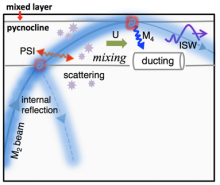Tidal forcing from the Sun and Moon generates 3.7 terawatts (TWs) of mechanical power, of which 3.5 TWs are dissipated in the ocean. It has become understood how energy is transferred into the internal wave field when barotropic tides pass over underwater topography and generate internal tides (internal waves at tidal frequencies), but the principal locations and pathways of internal tide dissipation are still unknown. Laboratory and idealized numerical model studies suggest that internal tide beams may lose energy in the upper (< 1km) ocean due to a variety of processes. Additionally, observational evidence indicates that internal tide beams weaken after reflection near the ocean surface, raising many questions about the energy pathways of internal tides in the upper ocean. We aim to simulate upper ocean internal tidal beam decay processes and quantify their associated energy loss as a function of depth and horizontal distance from the tidal beam generation site. Energy-extracting processes such as ducting, shear instability, and the nonlinear generation of internal solitary waves, vertically-confined mean flows, and M2 harmonics/subharmonics will be investigated in the context of the Kauaii Channel in Hawaii.
Image caption :
Cartoon of some of the processes that can occur during a tide beam surface reflection. Dissipation of M2 internal tide energy in the upper ocean can lead to enhanced mixing due to a variety of phenomena : scattering, “local generation” of internal solitary waves (ISWs), parametric subharmonic instability (PSI), induced mean flow (U) and higher harmonics (e.g., M4), and the vertical trapping (“ducting”) of wave energy.





